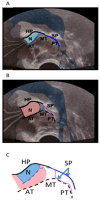Persistent Nipple Pain in Breastfeeding Mothers Associated with Abnormal Infant Tongue Movement
- PMID: 26404342
- PMCID: PMC4586646
- DOI: 10.3390/ijerph120910833
Persistent Nipple Pain in Breastfeeding Mothers Associated with Abnormal Infant Tongue Movement
Abstract
Background: Infants of breastfeeding mothers with persistent nipple pain have been shown to apply stronger vacuums to the breast and transfer less milk during one monitored feed. This may be associated with differences in the movement of the tongue. The aim was to analyse the intra-oral nipple shape and movement of the tongue of infants of mothers with and without nipple pain.
Methods: Breastfeeding infants of mothers with or without nipple pain were monitored using ultrasound and intra-oral vacuum during one breastfeed. From cine clips of the ultrasound scans measurements were made of the depth of the intra-oral space between the hard-soft palate junction (HSPJ) and the mid-tongue; the distance of the tip of the nipple to the HSPJ; and nipple diameters from the tip to the base.
Results: During nutritive sucking, tongue movements of infants of mothers with nipple pain resulted in a smaller intra-oral space (p = 0.040) and restricted nipple expansion compared to controls (p < 0.012). Stronger baseline and peak vacuums compared to controls were confirmed (p = 0.002).
Conclusion: In these mothers, nipple pain was associated with restricted infant tongue movement. Ultrasound may complement measurement of intra-oral vacuum in monitoring treatment strategies in breastfeeding women experiencing nipple pain.
Keywords: breastfeeding; infant; lactation; nipple pain; sucking behaviour.
Figures



Similar articles
-
Infants of mothers with persistent nipple pain exert strong sucking vacuums.Acta Paediatr. 2008 Sep;97(9):1205-9. doi: 10.1111/j.1651-2227.2008.00882.x. Epub 2008 May 13. Acta Paediatr. 2008. PMID: 18489617
-
Characterisation of sucking dynamics of breastfeeding preterm infants: a cross sectional study.BMC Pregnancy Childbirth. 2017 Nov 17;17(1):386. doi: 10.1186/s12884-017-1574-3. BMC Pregnancy Childbirth. 2017. PMID: 29149869 Free PMC article.
-
Breastfeeding frequency, milk volume, and duration in mother-infant dyads with persistent nipple pain.Breastfeed Med. 2012 Aug;7:275-81. doi: 10.1089/bfm.2011.0117. Epub 2012 Mar 16. Breastfeed Med. 2012. PMID: 22424464
-
Caring for new mothers: diagnosis, management and treatment of nipple dermatitis in breastfeeding mothers.Int J Dermatol. 2012 Oct;51(10):1149-61. doi: 10.1111/j.1365-4632.2011.05445.x. Int J Dermatol. 2012. PMID: 22994661 Review.
-
Practice-based interpretation of ultrasound studies leads the way to more effective clinical support and less pharmaceutical and surgical intervention for breastfeeding infants.Midwifery. 2018 Mar;58:145-155. doi: 10.1016/j.midw.2017.12.007. Epub 2017 Dec 14. Midwifery. 2018. PMID: 29422195 Review.
Cited by
-
A brief gestalt intervention changes ultrasound measures of tongue movement during breastfeeding: case series.BMC Pregnancy Childbirth. 2022 Feb 1;22(1):94. doi: 10.1186/s12884-021-04363-7. BMC Pregnancy Childbirth. 2022. PMID: 35105336 Free PMC article.
-
Methodological procedures for ultrasonographic assessment of the tongue during sucking in full-term infants: A scoping review.BMC Pediatr. 2025 May 19;25(1):401. doi: 10.1186/s12887-025-05636-2. BMC Pediatr. 2025. PMID: 40389930 Free PMC article.
-
Re-thinking lactation-related nipple pain and damage.Womens Health (Lond). 2022 Jan-Dec;18:17455057221087865. doi: 10.1177/17455057221087865. Womens Health (Lond). 2022. PMID: 35343816 Free PMC article. Review.
-
25 Years of Research in Human Lactation: From Discovery to Translation.Nutrients. 2021 Aug 31;13(9):3071. doi: 10.3390/nu13093071. Nutrients. 2021. PMID: 34578947 Free PMC article. Review.
-
Efficacy of a Breastfeeding Pain Self-Management Intervention: A Pilot Randomized Controlled Trial.Nurs Res. 2019 Mar/Apr;68(2):E1-E10. doi: 10.1097/NNR.0000000000000336. Nurs Res. 2019. PMID: 30829925 Free PMC article. Clinical Trial.
References
-
- Kramer M.S., Kakuma R. The optimal duration of exclusive breastfeeding: A systematic review. Adv. Exp. Med. Biol. 2004;554:63–77. - PubMed
-
- Schwartz K., D’Arcy H.J., Gillespie B., Bobo J., Longeway M., Foxman B. Factors associated with weaning in the first 3 months postpartum. J. Fam. Pract. 2002;51:439–444. - PubMed
Publication types
MeSH terms
LinkOut - more resources
Full Text Sources
Other Literature Sources
Medical

